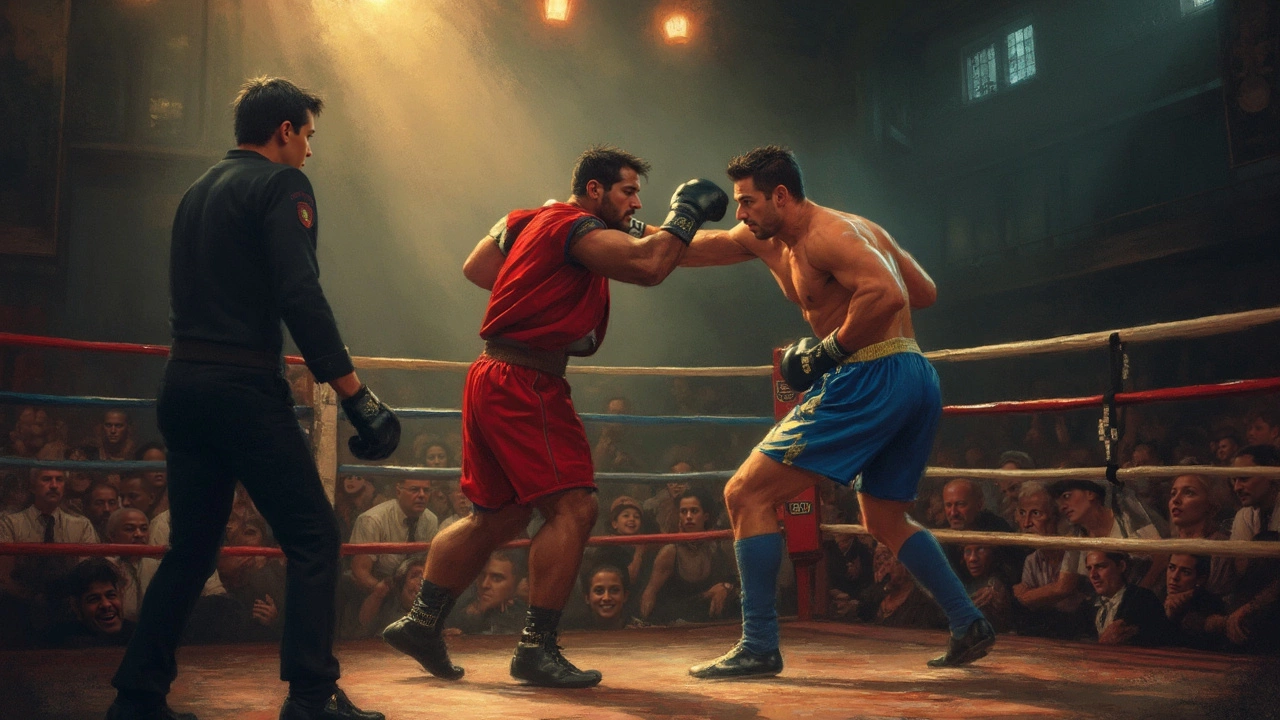Boxing might look like it’s all about swinging fists, but there's so much more happening beyond the punches. Have you ever noticed how boxers almost dance around the ring? That's the art of footwork, a key pillar in a fighter's skill set. Good footwork can make or break a fight, helping a boxer dodge punches and set up powerful hits.
But wait, there’s more. Ever heard the expression, 'the best offense is a good defense?' In boxing, defensive skills are vital. From head movement to blocking and parrying, mastering defense is crucial for longevity in the sport. It's not just about avoiding getting hit; it's also about setting the stage for counterattacks.
Understanding the Basics
Let's dig into what makes boxing more than just a flurry of punches. The first thing to know? Each match takes place in a ring, usually a squared platform that's 16 to 20 feet across. Fighters square off here, but it's not just about raw power. It's a mix of technique, strategy, and finesse.
Boxing Stance
Your stance is your foundation. Ever seen a boxer with their hands down, legs too close together? It's rare, because a solid stance gives the balance and mobility needed for both defense and attack. Generally, you’ll find the orthodox stance, where the left foot is forward, is common among right-handed boxers.
Punches 101
Sure, there are the iconic right hooks and uppercuts, but boxers use a specific set of moves known as the four basic punches: the jab, cross, hook, and uppercut. The jab is quick and keeps your opponent at bay, while the cross is powerful and straight. Hooks and uppercuts, on the other hand, come from the side or below.
Rules of Engagement
Boxing isn’t a free-for-all. There are strict rules to ensure fighters' safety and fairness. Only punches that land above the waist count. The match is controlled by a referee and judges keep score based on punches landed, defense, and overall control. A typical match comprises 3-minute rounds with 1-minute breaks in between.
The Importance of Weight Classes
Boxing separates fighters into weight classes to ensure that fights are fair. You won’t see a lightweight going against a heavyweight, because the differences are vast in strength and capability. These classes ensure competitors are matched fairly.
All this might feel like a lot of groundwork, but these basics are essential in grasping what techniques and strategies make a great boxer. With the basics covered, a fighter can then develop their unique style and strategy.
The Art of Footwork
When it comes to boxing, skilled footwork is like having a secret weapon. It’s not just about moving around the ring; it’s about strategic movement that gets you in position to land a hit or dodge an incoming blow. This element of the sport is what often separates good boxers from great ones.
Mastering the Basics
At the core of effective footwork is balance. Without it, a boxer can easily be knocked off their footing, making them vulnerable. A strong stance, with feet shoulder-width apart, provides stability. From this stance, quick, precise steps are key to maintaining balance while maneuvering around the ring.
- Positioning: Always align your lead foot towards your opponent, which enhances your reach and power.
- Pivoting: This technique helps create angles and opens up opportunities for punches.
- Shuffling: Short movements using both feet maintain distance and help rapidly change directions.
Why It Matters
Footwork dictates the pace of a match. A strategic move can put a boxer in an advantageous position, tipping the scales in their favor. Legends like Muhammad Ali and Floyd Mayweather are known for their exceptional footwork, which allowed them to evade punches and control the boxing match tempo.
Consider this while training: spend time drilling footwork as much as you practice landing punches. Good footwork not only supports your strategy; it transforms how you engage with opponents and respond to their tactics.
Steps to Improve
- Practice shadowboxing with a focus on footwork alone.
- Incorporate ladder drills to enhance agility.
- Use cones or markers in the ring to simulate opponents and plan movements.
By honing the technique of footwork, fighters not only punch but also dance around their opponent, demonstrating that boxing is truly an art form.

Defensive Strategies
A strong defense is like a sturdy shield in the boxing ring, and it's just as crucial as throwing powerful punches. Let's break down some key defensive strategies that fighters use to keep themselves safe and set up for their next move.
Head Movement
Head movement is all about making yourself a hard target. Boxers use slips, ducks, and weaves to avoid incoming punches. It looks effortless, but trust me, it's a skill that requires tons of practice. The ability to dodge a punch not only protects a fighter but can also create openings for counterattacks.
Blocking and Parrying
Another fundamental part of defense is learning how to block and parry. While blocking involves using the gloves to stop punches, parrying is about redirecting those punches away. It's not just about stopping the force; it's about guiding it away to avoid taking full impact.
- Blocking: Stopping a punch directly with the gloves.
- Parrying: Redirecting the punch with a slight push.
Foot Movement
Defense isn't just about using your hands. Footwork plays a significant role too. A nimble boxer can step out of range or pivot to change the angle. This isn’t just dodging, it's also about positioning yourself in the best possible place to launch your own attack.
Clinching
When things get intense in the ring, sometimes it's necessary to give yourself a breather. That's where clinching comes in. It's the art of grabbing onto your opponent to stop the flurry of punches. A well-executed clinch can break your opponent's momentum and give you precious seconds to regroup.
Counting Missed Punches
Evading punches can demoralize an opponent. A well-timed dodge or block can make the aggressor waste energy, leading to fatigue. A tired boxer is a vulnerable boxer, and that’s when opportunities arise for capitalizing on mistakes.
| Technique | Purpose |
|---|---|
| Head Movement | Avoids head punches |
| Block and Parry | Stops or redirects punches |
| Footwork | Moves out of range |
| Clinching | Stops opponent's momentum |
Psychological Game
We often focus on the physical demands of boxing, but the mental part of the sport is just as crucial. Getting into the opponent's head can be as effective as landing a power punch. Mind games are a big part of any boxing strategy. Before a match even begins, boxers often try to psych each other out at weigh-ins, when tensions are already running high.
Inside the ring, maintaining mental composure is vital. A boxer who loses focus, even for a second, can find themselves in trouble fast. This is where trash talk and psychological tactics can come into play. By projecting confidence or, conversely, showing controlled calmness, a boxer can unsettle their opponent, forcing them to make rash decisions.
Focus and Resilience
Another aspect of the psychological game is resilience. It’s not just about staying upright after a hard hit; it's about not letting that hit deflate your spirit. Many experts argue that boxing can teach profound life lessons in dealing with adversity. The key is learning to shake it off and not let disappointment cloud your judgment. If something goes wrong, boxers need to quickly adapt and keep their mind in the fight.
According to a study from 2021, where elite boxers were surveyed, over 70% indicated that mental toughness was crucial to their success. They emphasized visualization and meditation as part of their training regimen to help manage stress and maintain focus.
Understanding the psychological element gives you a better grasp of boxing’s complexity. It's not only about who punches harder but who can remain cool under pressure and outthink their opponent.
